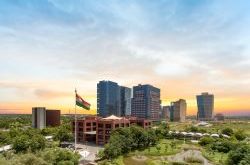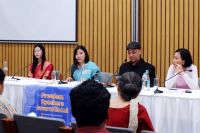Nestled amidst the Western Ghats, a UNESCO World Heritage Site renowned for its biodiversity is the Koyna Wildlife Sanctuary (WLS) in Satara, Maharashtra. In such a scenario, conservation activities are integral to maintaining a sustainable relationship between local communities and the environment. However, conservation efforts often face several hurdles, including socio-ecological layered complexities, especially when projects focusing on conservation activities are implemented in areas with a long history of human-nature interaction.
Near Koyna WLS, one such plantation project, undertaken by the Wildlife Research and Conservation Society (WRCS), aims to create a forest corridor between Koyna WLS and Chandoli National Park (NP). With climate change pushing weather patterns to unheard extremes, new challenges have arisen for the project. The summer heat is far worse than it used to be a few years ago and rains have become rather erratic. It is within this context of climate extremities and a growing need to reforest spaces that WRCS has undertaken this forest plantation project on privately owned land as part of conservation efforts. Consequently, the organisation has also been confronting formidable challenges in ensuring the survival of this project.
During our immersive field visit to this corridor area in March, as part of the ‘Conservation and Society’ course at FLAME University, we learnt about the various socio-economic and ecological challenges and observed how WRCS was striving to turn their plantation project into a resilient model. Against the backdrop of environmental uncertainty, this initiative is significant amidst the urgent need to reforest spaces.
For the project to move forward, two sets of challenges had to be overcome. First, locals in nearby villages had to be involved and convinced of the project’s benefits. Following this, ecological challenges had to be tackled. Initially, the local people were skeptical of their plantation and conservation initiatives. Although it is a common response among local communities towards external conservation efforts, such situations should be dealt with sensitively. Hence, it took a couple of years for the WRCS officials to gain their trust and foster collaborative approaches. Interestingly, it was relatively easier for WRCS to gain the trust of the locals because of their profile as an NGO and their lack of involvement in forest department affairs.
Challenges arose due to the prevalent local practice of uprooting and chopping trees for firewood due to the inadequate availability of cow dung as fuel. Moreover, cattle grazing and setting fire to the deforested area had been degrading the land where the plantation activities were being carried out. With such practices in place, it was difficult for the planted species to grow without facing the threat of felling. Building trust and enhancing communication with the local community enabled WRCS to establish more favourable conditions for plantation initiatives.
Locals were encouraged to invest in government-subsidized LPG, besides engaging in a more sustainable wood harvesting method by cutting only a few tree branches. They started practising stall feeding, which has helped reduce nutrient loss in the soil and have been showing more initiative in helping to manage the deliberately set forest fires in the region. With their active involvement with WRCS, the labour-intensive tasks of plantation and monitoring are also being effectively executed. Moreover, the locals also help keep an eye out for wild animals and forest fires.
Once the issues of excessive grazing and fires were handled, greater attention could be given to nurturing the tree saplings that would eventually fill the corridor area. Several measures were put in place so that these plants survive and grow to be healthy. At the nursery, they are grown in native soil to promote adaptation to local conditions for transplantation. However, WRCS Project Officer Mr Sunil Kale mentioned that chemical pesticides are sprayed in moderation on the saplings at the nursery. Further details, like which pesticides and how often they were used, are not known to us. The saplings are transplanted at the main site using the process of mulching, wherein the roots of the plants are packed with some organic matter before they are lowered into the soil. This helps preserve water and to regulate the temperature below the soil. Additionally, mulching also helps revive the land/soil degradation caused by grazing and forest fires by creating a favourable microclimate in the soil.
For the survival of the plantation, the choice of the plant species is quite important. Invasive species like Lantana are uprooted to reduce competition. Native trees are preferred since they adapt better to the region’s hot, dry summers despite the heavy monsoon rains. Various compatible species are planted alongside each other. Together, they mitigate external pressures efficiently, thereby raising the chances of survival. WRCS has also chosen to plant economically beneficial species along with ecologically suitable ones, thereby helping locals earn more by selling minor forest produce from them while establishing a forest corridor. The native varieties including Pongamia pinnata and Shikakai are both ecologically and economically viable. Many species, like Hirda, Behda, and Nakya have medicinal properties as well.
The WRCS plantation project serves as a model for a holistic approach towards reforestation that gives attention to all elements like soil health, micro-climate, species diversity, as well as community engagement. Although WRCS has overcome various obstacles, some challenges remain in establishing the corridor plantation. Climate change, with rising temperatures and water scarcity potentially hinders the survival of saplings. Moreover, stall-feeding practices for cattle are attracting wild animals towards the villages, increasing the probability of human-wildlife conflict.
Despite these persisting challenges, the project has benefited people greatly. Many of the locals who had migrated to larger cities in search of work have returned to their villages since the plantation area provides livelihood security from minor forest produce and ecotourism revenue. One of the project’s most active locals, Mr Ritesh, used to work as a cashier at a grocery store in Mumbai. He returned due to the opportunities at the plantation and others have followed his example as well. The project’s success demonstrates how a symbiotic relationship can be created, in which nurturing the ecosystem can benefit the local communities and ensure sustainability in the long run. In the words of the project officer Mr Kale, “It is not about how many we plant, but how many we save”.
- By Devabala Smitha, Sargam Sundrani, Siddha Murada, and Tvishi Rajesh
(Students of Environmental Studies program at FLAME University)
 Newspatrolling.com News cum Content Syndication Portal Online
Newspatrolling.com News cum Content Syndication Portal Online






